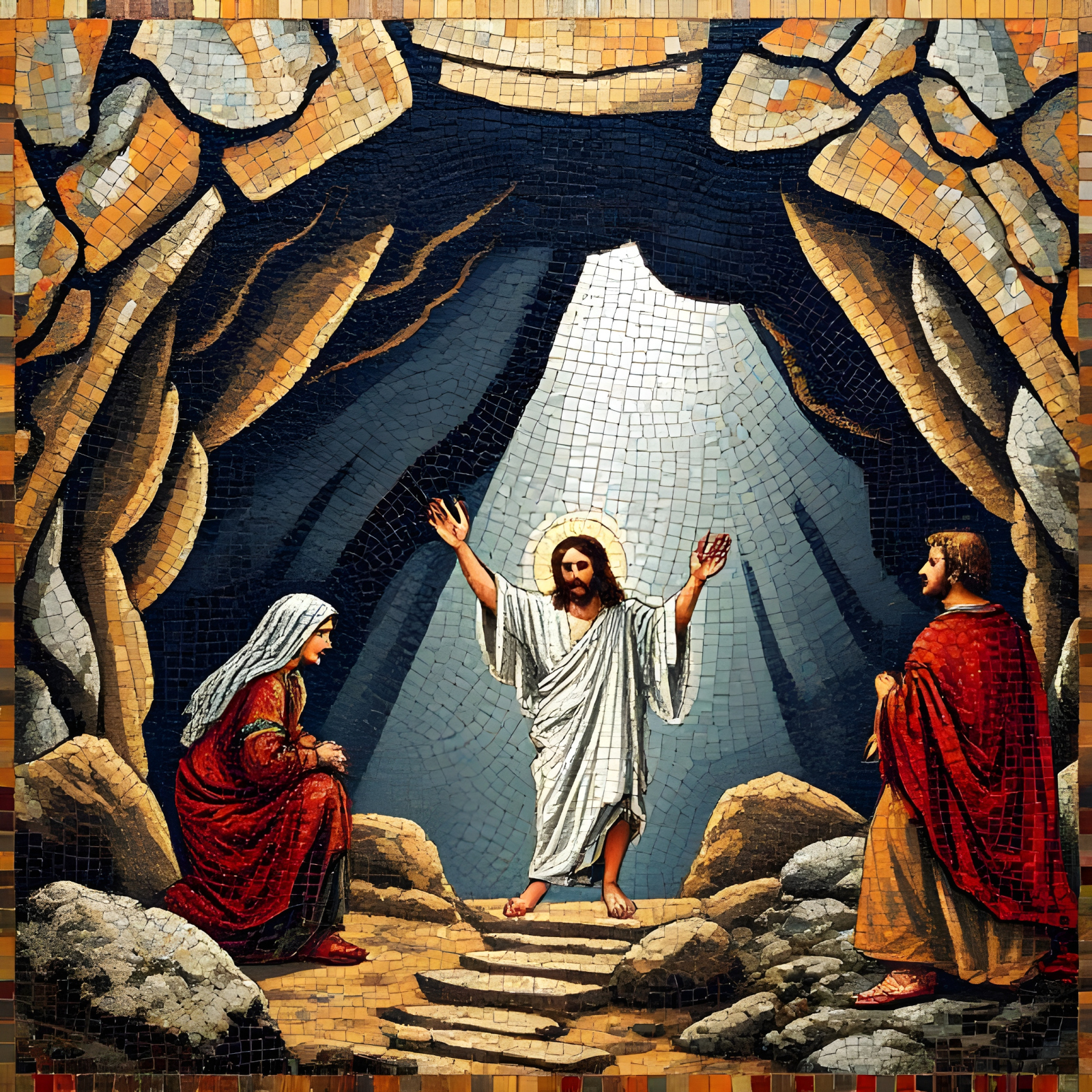Deep Thoughts with Deep AI: an Epistemological Murder Mystery
Once men turned their thinking over to machines in the hope that this would set them free.
But that only permitted other men with machines to enslave them.
— Frank Herbert, Dune
(spoken by Rev. Mother Gaius Helen Mohiam)

 Over the weekend I decided to toy with something I haven’t seen much of:
using AI image generation for religious illustrations.
In particular, Easter was coming up, and I wanted to update
the image on my homepage.
After a quick DuckDuckGo search I ended up at DeepAI’s
AI Image Generator.
I’m fond of mosaics, so I decided to generate some of those.
It’s worth mentioning that this isn’t my first attempt to generate mosaics,
and the last time around was an abject failure:
I could not get the thing to generate a decent mosaic-like image for anything.
So my expectations weren’t high.
Over the weekend I decided to toy with something I haven’t seen much of:
using AI image generation for religious illustrations.
In particular, Easter was coming up, and I wanted to update
the image on my homepage.
After a quick DuckDuckGo search I ended up at DeepAI’s
AI Image Generator.
I’m fond of mosaics, so I decided to generate some of those.
It’s worth mentioning that this isn’t my first attempt to generate mosaics,
and the last time around was an abject failure:
I could not get the thing to generate a decent mosaic-like image for anything.
So my expectations weren’t high.
First attempts
The prompt,mosaic of jesus rising from the grave while mary and john watch
turned out something so horrifying that I’m blurring it.
Click the image or hover with your mouse over the image if you want to see it, but you’ve been warned.
That’s hardly the only one;
every single image I generated with that prompt was something horrifying.
I’m so scarred I’m reluctant to try it again.
(Yes, I’m exaggerating.)
(But not much.)
Let’s change the subject
I gave up on Jesus’ rising from the tomb and went for an image from Revelations:mosaic of a lamb seated no a throne
surrounded by saint mary and saint john
That gave me this entirely reasonable image.
See how many “AI gaffes” you can find.
I fixed up a few and shared it with family and friends.
Every last one of them immediately took delight in discovering the gaffes which had slipped past me.
Thank God I wasn’t expecting any affirmation.
✠To be fair, I’m not exactly “Mr. Affirmation” myself,
and while I told them “not to look too closely” most of the gaffes they found made me
wonder,
“How’d I miss that?!?”.
Thusly motivated, I whipped out the GIMP
and edited the image to this hopefully-final result.
After all the effort I’d put into the first result,
I can’t resist using that as my homepage’s welcome image for a bit.
Resurrection, Take 2
Still, it’s Easter, so I wanted something more resurrection-y. This evening I took another stab at it, trying to avoid the phrase ”rising from the grave”, lest DeepAI have another demonic seizure. So, can I rephrase✢The bien-pensant assure us that AI will free workers from labors that are tedious and repetitive. Their new jobs will require them to spend their time repeatedly wordsmithing a prompt until an AI produces a passably acceptable result. Put succinctly, life will go from tedious drudgery to… even more tedious drudgery. This is somehow considered an improvement. “rising from the grave”? Traditionally, icons of the resurrection depict Jesus’ tomb as a cave of some sort, so I figured I’d replace “tomb” with “cave”. At first I didn’t want to tempt DeepAI with “rising” from a tomb, either, so I tried “emerging from a cave”. That brought me to:
mosaic of jesus emerging from a cave while mary magdalene st peter and st john watch in amazement
…which gave me this rather pleasant image:
Granted, I asked for two apostles and got only one,
and I’m not sure I see “amazement” in the saints’ faces,
but I like this all the same:
- “AI gaffes” aren’t evident, or if so, you really have to hunt for them. Curiously, Deep AI offers a choice between “Speed” and “Quality” and when generating this I had it set to “Speed”.
- The image has a tiled border! I don’t recall seeing that in other mosaics I created.
- The lighting makes sense. How’d that happen? Considering all the extra fingers, deformed feet, and unnatural eyes I’ve seen, how on earth is the lighting that good? Is it an easier problem to solve, or did they just train the AI more on that?
Elsewhen on Resurrection Sunday
One of my favorite passages in John’s Gospel is Jesus’ appearance to Mary Magdalene. I decided to try prompts like this:
weeping mary magdalene meeting jesus in a garden outside a tomb
…also trying “cave” instead of “tomb”, because… you know.
This produced images along these lines:
These results are much better!
- In the first image, I notice:
- Mary’s striped robe.
- Jesus has no beard. The early Church often portrayed the resurrected Jesus without a beard, symbolizing eternal youth.
- Does the jar on the stand contain oil to anoint the body?
- Is that supposed to be a bag beside the stand? Are those linen cloths?
- The tree… is growing into, or supporting the wall. There’s a harmony to that.
- In the second image,
- Jesus is portrayed as old, which could explain why Mary doesn’t recognize him. I doubt the AI had St. Irenæus in mind, but that’s still quite the coincidence. (Irenæus claimed that Jesus went through all the stages of life, including old age, before returning to heaven. Offhand I don’t remember if he also claimed Jesus was old at his crucifixion.)
- Mary looks downcast, more than in the first image.
- The faces are passably good for a change. Mary’s face is so good that one might explain away the gaffes in Jesus’ face as her inability to recognize him.
- That garden is interesting, with a wide variety of plants.
mosaic of a weeping mary magdalene meeting a hooded jesus showing his wounds in a garden outside a tomb
…though I liked the last image enough to keep:

You can chat with the scene!
DeepAI includes a button that allows you to chat with the character(s) generated in the image. I tried that with the image above, using the promptwoman, why are you weeping
…obtaining:
On the plus side, it’s clever enough to realize there are two people in the scene,
and to have them dialogue with each other.
Amazingly, it catches the Biblical context of the image
and demonstrates awareness of what happens.
Points and plaudits for that, why not. 🏆 🥇
But did it need to invent all that… treacle?
The Biblical account is sober and succinct, which contributes to its emotional power.
The AI seems to want to decorate it with sentiment to the point of saccharine,
which both lessens the punch and leads to an inconsistent account.
And what’s with the Yogasleep Dohm ad?!?
Appendix
(What follows below is essentially a digression where my mind wandered a bit.
You can stop reading and miss nothing important.)
…but is it art?
I dunno. I’m not an artist. I decline to answer.…well, is it at least useful?
The images are attractive enough that I may try this for my Christmas cards this year.✗ Unless one of my artistically-inclined daughters relents and draws me one, but I’ve had no luck these last several years. I can see how someone could use this as a start, clean it up a little, the way I did the lamb on the throne, and pass it off as original work. In a way, it would be.…but is it intelligent?
When people use AI as a shortcut to- write an essay,
- write a computer program,
- control traffic lights,
- diagnose a disease,
- identify a criminal or a terrorist,
A “better” test for artificial intelligence
Could an AI create itself? AI doesn’t seem capable of creating new problems, at least not yet. Its abilities end with re-solving solved problems: faster, yes, and in many cases, more accurately than humans. I think this illustrates my dislike of the Turing Test of Artificial Intelligence. I’ve read that some generative AI’s are producing conversations sufficiently sophisticated that people can’t distinguish them from humans, which means they past the Turing Test. If that’s all it takes, then the Turing Test is a bad definition. I’ve not previously been able to articulate what precisely bothers me about that definition, but these explorations with DeepAI seem to help. Suppose you were looking at a piece of art, and you couldn’t tell whether it was made by a professional artist or a four year-old child. Would that make the four year-old child an artist? Take the argument one step further: suppose you couldn’t distinguish between a famous painting of a master and a highly skilled forgery. Would that make the forger an artist equal to the master? Finally, suppose you couldn’t distinguish between an image generated by giving DeepAI a prompt and a genuine work of art. Would that make DeepAI an artist? The answer to all three seems obvious: no. Imitation is not creation. The Turing Test is similarly flawed. Frank Herbert distilled this concern some decades back:
Education is no substitute for intelligence.
That elusive quality is defined only in part by its puzzle-solving ability.
It is in the creation of new puzzles reflecting what your senses report that you round out the
definition.
Let’s call that the Herbert Test for Artificial Intelligence.
My PhD adviser presented the same idea, but a different way:✘Not an exact quote. I may have botched the memory. Don’t blame him if
it’s obviously stupid.
— Frank Herbert, Chapterhouse: Dune
Mentat Text One (dicto)
In mathematical research, not only do you not know the answer,
sometimes you don’t even know the question.
The solution is often trivial once you find the right question.
The Turing Test assumes that a machine becomes intelligent
once it can solve a puzzle quick enough.
The Herbert Test requires more: a machine becomes intelligent
only once it can create the puzzle it needs to solve.
Granted, AI’s can solve puzzles faster, more accurately, and more effectively than humans.
But humans can recognize a problem that needs to be solved,
then invent new puzzles, or even “games”, which model these problems.
Can an AI create genuinely new puzzles?
Can it invent genuinely new mathematics?
I’m not aware AI’s can do that.
That’s the singularity I’ll worry about more.







